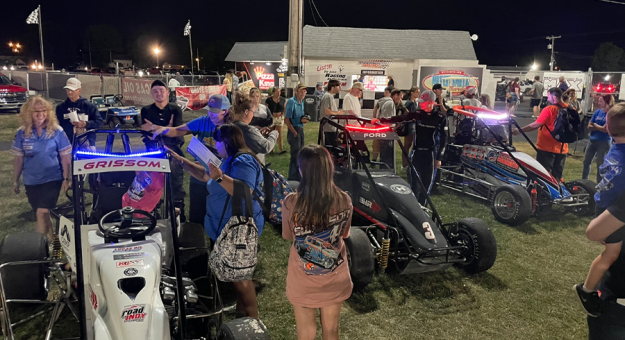Anytime there is an advancement in any industry there is always the unknown of the first time it’s put into use.
During the Don and Mel Kenyon Classic for the Kenyon Midget Series at Anderson (Ind.) Speedway, faces got to experience a first in any form of motor racing.
It marked the first trial of the Leading Lights concept being pioneered by founder Turner Woodard, who was on hand to watch the initial trial.
Fans watching the Kenyon Classic could keep track of the top three cars without having to glance at the scoreboard.
The leading car displayed a blue light on the roll cage, a red light for second and a white light for third.
The lights were prominently displayed when the race cars raced through the shaded portions of Anderson Speedway, but were clearly visible around the entire quarter-mile oval.
As the positions changed during the 75-lap race, as the top three cars crossed the start/finish line the lights remained the same or changed to reflect the top three contenders.
From the reactions of the fans after the Kenyon Classic and long time race followers in the control tower, the Leading Lights test and concept passed with flying colors.
Earlier this year, Woodard said it used to be drivers got information about competitors by a crew member holding a chalk board. “It was that way when I raced at Mid-Ohio 30 years ago and it always seemed so crude,” he said.
Woodard said there had to be a way to help the fan. He purchased the patent and realized it was a simple idea in a complex sport.
The light system is tied in with the scoring system so the fans will always know who the front runners are.
Woodard said IndyCar used side lights that the fans liked but the cars went past so fast it was hard to read.
“I was looking all around,” he said of finding a series to showcase the system. “It had to be the right person to make it happen.” Woodard said the light system will also aid the drivers in knowing who they’re trying to catch during a race. He said it will aid the spotters and let slower traffic know when the leaders are approaching.
The system would prove to be significant at a dirt track where the cars tend to kick up a lot of dust making the numbers hard to read.
“We believe there are several benefits to the system,” Woodard said. “I thought with Brad (Hayes) background we could make the system right and help develop it.”
Woodard believes the Leading Light system could be used by NASCAR, IndyCar and other traveling series in the future.
“It’s about enhancing the fans experience,” he said.
